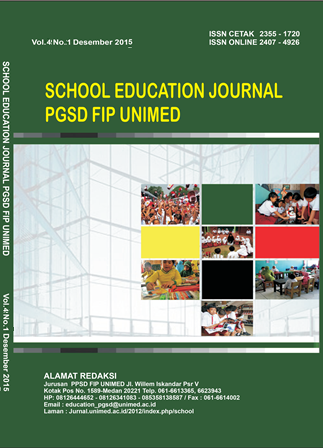UPAYA PENINGKATAN HASIL BELAJAR MATEMATIKA SISWA MELALUI MODEL PEMBELAJARAN KOOPERATIF TIPETUTOR SEBAYA DI SMP NEGERI 3 SATU ATAP BANGUN PURBA
DOI:
https://doi.org/10.24114/sejpgsd.v4i1.2981Abstract
Abstrak Penelitian ini bertujuan untuk melihat peningkatan hasil belajar siswa melalui model pembelajaran kooperatif tipe tutur sebaya.Awal KBM dilakukan tes hasil belajar (Pretes), dengan data rata-rata 26,1 hal tersebut menunjukkan bahwa rata-rata siswa jarang membaca buku sebelum pembelajaran disekolah. Kemudian dilanjutkan KBM, akhir KBM ke II dan KBM ke IV dilakukan tes hasil belajar formatif I dan formatif II dengan rata-rata hasil belajar masing-masing menunjukkan 60,7 dan 85,7. Data aktivitas siswa menurut pengamatan pengamat pada siklus I antara lain membaca/menulis (41 %), mengerjakan LKS (24%), bertanya sesama teman (8 %), bertanya kepada guru (14%), dan yang tidak relevan dengan KBM (13 %). Data aktivitas siswa menurut pengamatan pada siklus II antara lain membaca/menulis (24 %), mengerjakan LKS (50 %), bertanya sesama teman (19%), bertanya kepada guru (2 %), dan yang tidak relevan dengan KBM (6 %).Kata Kunci: Model Kooperatif Tipe Tutor Sebaya, Hasil BelajarDownloads
Published
Issue
Section
License
Authors whose manuscripts are approved are approved as follows:
The publication rights for all journal manuscript materials published/published on the SEJ (School Education Journal) E-Journal site are held by the editorial board with the author's knowledge (moral rights remain with the manuscript authors).
The formal legal requirements for accessing this electronic digital journal article are subject to the terms of the Creative Commons Attribution-ShareAlike (CC BY) license, which means that E-Journal SEJ (School Education Journal) has the right to store, transfer media/format, manage in the form of a database, maintain, and publish articles without asking permission from the author as long as the author's name remains as the copyright owner.
Manuscripts published/published electronically are open access for educational, research, and library purposes.

